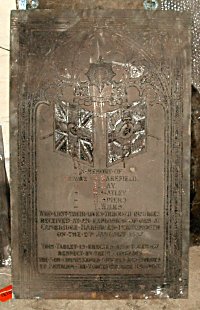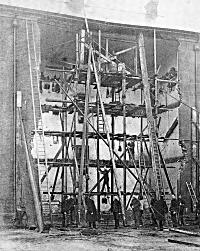At the English Heritage store, Fort Brockhurst, Gosport [EH Ref No: 87900130]. The plaque was originally placed on the north wall, between the second and third windows from the west end. In 2006, the memorial was sent on loan to Portsmouth Grammar School which took over Cambridge Barracks in 1926.
The memorial is made of metal, is in a dirty and damaged condition and is showing the effects of having been in a fire.

Cambridge Barracks (1)

The damage to the barracks. Photo
Courtesy of the Worcestershire Regimental
Archive.
Cambridge Barracks (2)

The Barracks c1900. The repaired section
can be seen on the extreme right. Photo
Courtesy of the Worcestershire Regimental
Archive.
Cambridge Barracks (3)

Portsmouth Grammar School 2006.
The repaired section is still discernable.
Gravestone

Gravestone at Highland Road Cemetery
|
PRIVATE " " " " |
J. WAKEFIELD
T. KAY W. GATLEY H. SPIERS T. WILKS |
RECEIVED AT AN EXPLOSION OF GAS AT
CAMBRIDGE BARRACKS PORTSMOUTH
ON THE 2nd JANUARY 1887
THIS TABLET IS ERECTED AS A MARK OF
RESPECT BY THEIR COMRADES
THE NON-COMMISSIONED OFFICERS AND PRIVATES
2nd BATTALION THE WORCESTERSHIRE REGIMENT
Further Information
At the top of the memorial is the Valise Star as used by the Worcestershire Regiment. Below the star on a scroll is the motto "FIRM" which was the used in this way by the 2nd Battalion Worcestershire Regiment (previously the 36th of Foot). It was not until 1881 that the 29th (Worcestershire) Regiment and the 36th (Herefordshire) Regiment were amalagamted and became the 1st and 2nd Battalion Worcestershire Regiment respectively. At the same time the 1st and 2nd Worcestershire Militia Battalions became the 3rd and 4th Battalion Worcestershire Regiment.
See also the The Worcestershire Regiment web site
Report from the Hampshire Telegraph, 8th January 1887, Page 6
On Sunday night, about 9 o'clock, Portsmouth was alarmed by a loud report, which many, not noticing the exact time, at first erroneously attributed to the firing of the evening gun, but subsequent events proved that it was from a terrible explosion at Cambridge Barracks, High St., Portsmouth. The cause of the disaster is attributed to an explosion of gas, of which it is reported, a smell had previously been detected.
The scene of the explosion was the three barrack rooms, rising one above the other in the block of buildings almost facing the entrance gateway, and slightly to the westward.
The rooms lead out of 'C" passage and are occupied respectively by "F", "G" and "C" Companies of the 2nd. Battalion Worcester Regiment, which corps is stationed in the Barracks. As is pretty generally known, the buildings are very solid and substantial.
At the time of the explosion the number of soldiers in the three rooms could not be estimated with accuracy, some being subsequently discovered to be away on pass and from other causes.
For a little while after the explosion the fact was not very generally known outside the barracks, but inside it was painfully apparent. The report was followed by a concussion which broke the windows of
almost every quarter of the barracks, and stones, bricks and woodwork were hurled with great violence across the parade....the entire front of the three tiers of barrack-room in question had been
blown out bodily into the square....
Lanterns and ships' lights were sent for.......other regiments in the garrison hastened to render assistance. As well as the front.......floors fell and imprisoned many in their rooms.....burying occupants beneath the debris.
Roads were frozen - soldiers pulled the ambulances (the horses could not walk on the slippery roads) to and from the Station Hospital on Lion Terrace. Hundreds f people were outside the barracks......Many men had narrow escapes......It was very cold, rain fell heavily . Work went on steadily until 20 had been rescued......at 3 am on Monday the operations were temporarily suspended ......until daylight......those who were known to be past human help. (Many complained about the rescue being stopped until the morning.)
Little doubt seems to be now felt that the cause of the disaster was an explosion of gas, which must, it is thought have been collected very low down in the basement, as the force of the explosion was greatly felt below the flooring boards in the lower room, thus showing that the explosive power must have been from below, and not above.
Casualties.
Private Wakefield - Killed
Private Gateley - Killed
Private Keay - Killed (later this was spelt KAY)
Private Long - wound
Private Wilks - fracture (since dead)
Private Rowlands - contusion
Private Adams - wound
Private Prince - wound
Private Colley - contusion
Private Cooper - contusion
Private Neath - contusion
Private Perrin - contusion
Private Orton - contusion
Private Quarrel - wound
Corporal Cotterell - contusion
Private Jones - contusion
Private Burns - fracture
Private Westbury - Sprain
Private Spiers - Killed (This name only appeared in the account of the inquest)
Message from the Queen.
On Tuesday afternoon H.M. sent Colonel Byng from Osborne to make inquiries......inspected the ruins.....went to Station Hospital to meet the casualties. On Wednesday morning the Worcestershire Regiment paraded on the barracks square to hear a message from the Queen.
On Tuesday, the inquest (lists of all those present and full of all the gory details)
On Thursday pm. The funeral at Highland Road. Full military funeral.
In 2006
English Heritage agreed to a request from Portsmouth Grammar School to take this memorial on loan. The reason cited was that the Grammar School now occupied that part of Cambridge Barracks in which the 1887 explosion took place.
On the left of this page there are two photographs of the barracks. The upper, probably taken around 1900, shows the Parade Ground in front of the Barracks and on the right hand side the building itself can be clearly seen to have experienced major repair. The lower photograph, taken in 2006 from the same place shows that the damaged section can still be identified. The main entrance to the school is out of shot to the left of the former parade ground.
